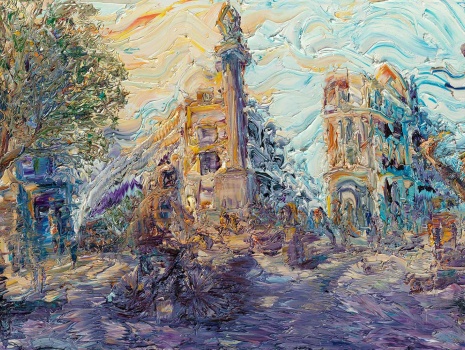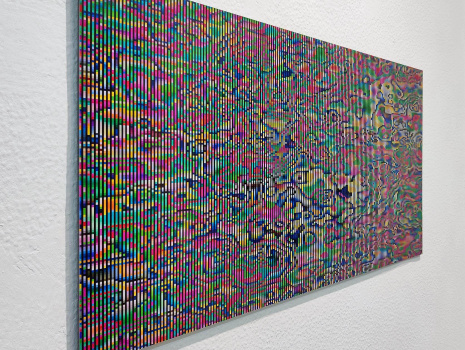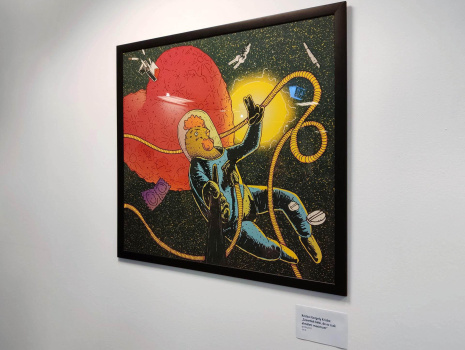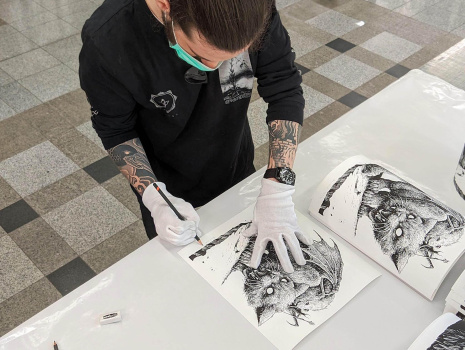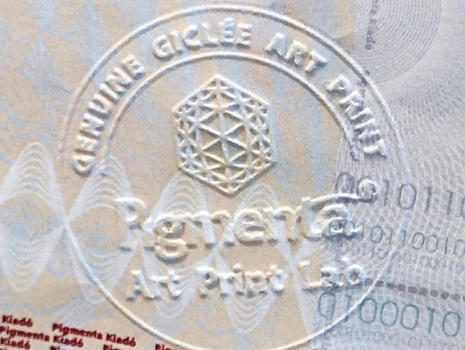GiclÃĐe Printing
GiclÃĐe Printing is a new and contemporary method of printing that meets the highest requirements of artists, museums and art collectors.
This ranks GiclÃĐe Printing with the more common, traditional graphic techniques such as etching, serigraphy and stone lithography.
The GiclÃĐe Art Print
Produced with the most modern techniques, GiclÃĐe prints are the highest quality prints, used by artists to make individual or low-run reproductions of original two-dimensional artwork, limited or open editions of photographs, computer graphics or computer generated imagery.
GiclÃĐe inkjet printing is a cooperation of the artist and the printmaker, which allows the artist to control every part of the printmaking process.
Seven Dials - ÂĐ Marcus Krackowizer, UK - GiclÃĐe print made from a Cruse art scan of the original painting
What does the word GiclÃĐe mean?
It is a French term and means to squirt. A GiclÃĐe Print is now associated with the highest quality inkjet printing technique.
True GiclÃĐe prints are produced with a very high resolution (1200dpi minimal to 2400 dpi) and are printed with precious archival inks on acid-free materials. The canvas and papers have been provided with a layer (coating), which ensures that the inks will not degrade.
Blending Art and Technology
Originals can be art generated on the computer, photographic art captured by digital cameras, any combination of such artistic data created in or out of the computer specifically for the giclÃĐe photo printing process, or high quality digital reproductions (scans or photographs) of original artwork.
"Semiramis" - ÂĐ NÃĄray, TamÃĄs - GiclÃĐe print made from the Cruse scan of the original painting
GiclÃĐe is the digital process of making art
GiclÃĐe - like all computerised processes - have three main parts: Input - Data management - Output.
Beyond the computer based art generation and digital photography the modern method of digitizing original pieces of art is the highest quality scanning. Pigmenta Art Print Lab uses the latest scanning technologies by Cruse Digital Imaging Equipments, operates the only large format fine art scanner in Budapest, Hungary.
In most cases the artist sits down with the printmaker at a high resolution monitor to crop, size, adjust softening, highlighting, colour, and/or to manipulate all or selective parts of their image. This is all done with sophisticated graphics software, where the possibilities for experimentation are virtually endless. A series of proofs help fine-tune the image in preparation for the final printing.
"Error" - ÂĐ ErdÅdy, JÃģzsef Attila - GiclÃĐe print of a digital art image
To create our fine art prints, we use the latest and highest quality printing system and selected materials.
The output is displayed on our Canon imagePROGRAF large format printers. The current leading Lucia 4 ink technology helps us to achieve brilliant colour space, superb colour accuracy, excellent colour graduation, longetivity and fade-resistance. The printers use twelve colours with a droplet size of 4 picoliters (1 picoliter = 1 trillionth of a litre). The printheads contain 2560 nozzles for each colours providing as high resolution as 2400 dots per inch. Our printers can handle cut sheets in A4, A3, A3+ sizes or 24" (61 cm), 36" (91 cm), 44" (111 cm) and 60" (152 cm) wide rolls.
Archival quality medias, papers and canvases for GiclÃĐe printing
Pigmenta Art Print Lab in Budapest provides a valuable line of printing media from HahnemÞhle, Fabriano, St.Cuthbert's Mill, and Breathing Color:
âĒ traditional archival quality fine art papers, watercolour, smooth or textured acid-free rag papers in various weights
âĒ photographic papers including traditional Baryta, RC papers with matte, luster and glossy finishes
âĒ canvases with different kind of basis e.g. - natural 100% cotton or high white poly-cotton for photos
âĒ metallic papers and canvas for reproduction of gold and silver with silvery-shimmering finish
Take a look at our full range of papers and canvases, you'll find the printing prices at medias' details.
Digital Color Management for colour consistency
The experienced staff at Pigmenta Art Print Lab use the latest hardware and software solutions to control the efficient workflow with optimal ICC profiles.
For this purpose our scanners, monitors and printers are calibrated with specific ICC profiles. Using professional print management software, the ideal colour space is defined for each device and print media. This guarantees the best colour reproduction of your paintings, photographs, prints, etc. on all output devices and media.
See for yourself the outstanding quality of works by Pigmenta Art Print Lab. We invite you for a personal presentation in our premises.
GiclÃĐe Art Editions
Etching, serigraphy and stone lithography are well known traditional graphic techniques. Photography used silver halide processes to make printed copies of the picture captured to original film. The digital age introduced revolutionary new printing devices and a completely new and contemporary printing technique. Printed Art is unique, authentic and original no matter how the digital image was created.
Rembrandt - The Mill 1641. - Etching - Museum Het Rembrandthuis Amsterdam
Ever since the invention of printing, artists have used the opportunity to make multiple copies of their works. No wonder that Rembrandt used the technique of etching for printing his drawings as editions. Several museums and galleries around the world exhibit GiclÃĐe reproductions instead of the original artwork. This demonstrates that the GiclÃĐe is accepted by the Art market.
There are fundamental differences in the sense that which territory of arts works originated from.
Making prints is an essential tool for the creation of tangible objects of art for photographers and computer artists. Printing reproduction editions from originals is a new opportunity for manual artists like painters and graphic artists. In the first case digital files are made by the artists, for the latter the original art has to be digitized. Many self publishing artists, photographers, collectors and galleries use our giclee printing service to create fine art, canvas or photographic prints from their original digital files or artwork.
"I love you baby, but this is just the theoretical maximum" - ÂĐ Krizbo - Krizbay, Gergely - GiclÃĐe print from the digitised drawing
Why Make Giclee Fine Art Prints?
The dream of reproducing your work in limited numbers and at a level of quality that makes it difficult to distinguish the print from the original is now a reality. This reality allows the artist to publish limited edition prints on canvas or paper and in so doing create a scalable income from a single painting.
Limited edition and open edition
Limited edition prints are an option open to all artists but it can depend on where you are in your career. Printing greeting cards or post cards may be the place to start, as a marketing step in order to generate more awareness and demand.
It may however work for the artist to publish a selection of their works as limited editions from an early stage. Buyers like the exclusivity of limited prints especially if they are signed and numbered. In addition, they will often pay more and take a risk in an unknown artist if the works will one day no longer be available. To explore the benefits and restrictions of Limited Editions find out more at next chapter: Authentication, Certification.
Print on Demand
The meaning is in the title. Unlike screen printing where a lot of colour matching must take place before each print run, which are then set to produce hundreds or thousands of prints, once the colour match is decided by the artist in the giclee process, the digital file is stored until needed. Later, giclee images can be produced as required or on demand after a sale is made, hence eliminating the high cost (and storage issues) of producing a complete edition at one time.
"All that matters now is what's in our hearts" - ÂĐ Schnedarek, RÃĐka - GiclÃĐe print made from the Cruse scan of her watercolour painting
Price and value of a GiclÃĐe print
Giclee printing allows the self publishing artist the opportunity to sell their work to a larger group of the population without devaluing their work or lowering the cost of their original pieces. By varying the size, substrate and if limited, the number of their prints, they can set prices to match the wallets of a range of potential customers.
With the potential range of products now available to the artist from greeting cards to prints on stretched canvas to the original, it is possible to make sales at all types of outlets. Many artists sell their giclee prints alongside their originals at exhibitions, local galleries, art fairs and markets. Some chose to sell through shared online galleries and some via theirown websites. A mixture is probably the right way to go but the beauty of giclee printing is that it gives the artist the chance to find out for themselves with affordable prices, prints on demand and quality they can be proud of.
Remember that a limited edition giclee print run does not have to be printed all in one go. You can cut down your costs by only printing what you sell and you benefit from not having unsold prints that have cost you money to produce and may never sell at all.
Authentication, certification
A GiclÃĐe art print's key authenticating element is the artist's own handwritten signature, similar to all painted or drawn arts. Numbering each copy of an edition is also very important.
The signature of Vincent Van Gogh
What details will identify a printed art edition?
Printed art can be a single copy, limited or unlimited edition. A set of similar prints can be considered as a limited edition, if the following aspects are identical for each copy: Name of the artist Title of the art Size of the art Base material the art is printed on (type of paper, canvas, etc.) Number of copies in the edition (the number of artists copies marked AC are mentioned sometimes) There are no strict rules for specific identification or registration for open editions.
Signs for identification, security marks on giclÃĐe prints
The most important element of the art's identification is the artist's signature and/or his/her stamp or embosser. A printed image of the signature and/or logotype of the artist is accepted and more common on new digital editions of photography and computer arts.
Artist is signing GiclÃĐe prints - BorbÃĄs, RÃģbert
Accompanying Certificate of the GiclÃĐe Art Print
The certificate is the licence letter made for the art print. It contains the identification data of the print and the edition, including a statement by the artist and the publisher that no more copies will be printed as described. The certificate records the printing dates of the first and the current copy.
Pigmenta holographic ID sticker
All edition prints made by Pigmenta Art Print Lab are registered. We register all printed copies of editions to ensure the continuous numbering and control of the work. This administration is made as Pigmenta Publishing. A matching holographic sticker correlating to the associated certificate is placed on the back of every edition. The sticker shows our logo and a serial number. Our certificates are designed with special graphic objects used on banknotes. They show all information about the print and the edition in Hungarian and English and hold the signatures of the artist and the representative of Pigmenta Publishing together with our embossed stamp and holographic sticker.

 HU
HU
